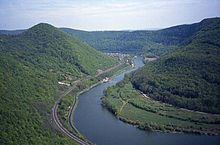Native name Le Doubs Discharge 176 m³/s Basin area 7,500 km² | River mouth Saône175 m (574 ft) Length 453 km | |
 | ||
Bridges Pont battant, Pont de Navilly | ||
The Doubs (French: Le Doubs, [du], German: Dub) is a 453 kilometres (281 mi) long river in eastern France and western Switzerland, left tributary of the Saône. Its source is near Mouthe in the western Jura mountains, at an altitude of 946 m. It is the tenth longest French river in terms of length within France.
Contents
Map of Le Doubs
CourseEdit
From its source in Mouthe it flows northeast, more or less along the French-Swiss border (forming the border for approx. 40 km). Near Montbéliard it turns southwest, until it flows into the river Saône in Verdun-sur-le-Doubs, approx. 20 km northeast of Chalon-sur-Saône. Its entire course resembles an inverted letter U, with the northeastern corner the only point at which the Doubs flows into Switzerland as far as Saint-Ursanne. In Switzerland it traverses the cantons Jura and Neuchâtel.
The waterfall known as the Saut du Doubs is located on the French-Swiss border.
The Doubs flows through the following Departments of France, Cantons of Switzerland, and cities:
Tributaries include:
The river forms several lakes:
Floods and Seasonal VariationEdit
The rate of flow of the Doubs is very seasonally variable. The flooding season can stretch from September to May, with floods being occasioned either by heavy rains or by quick melting of snow from the Jura mountains. At its mouth, the discharge rate can vary from as low as 20 m³/s to over 1000 m³/s during floods.
In Besançon, the largest floods have been in 1852 (8.50 m), in 1896 (7.96 m) and in 1910. There have also been many lesser floods more recently.
HydroelectricityEdit
As a mountain river with substantial discharge, the Doubs has been used for electricity generation. Among several hydroelectric stations, the most important are the Dam of Châtelot, 74 metres tall, and the Dam of Refrain, 66.5 metres tall.
